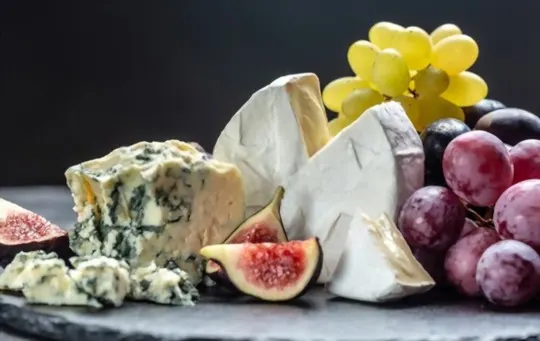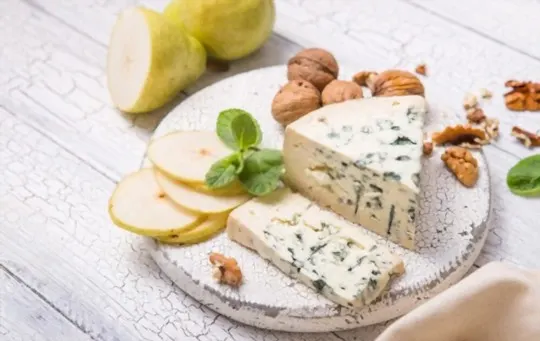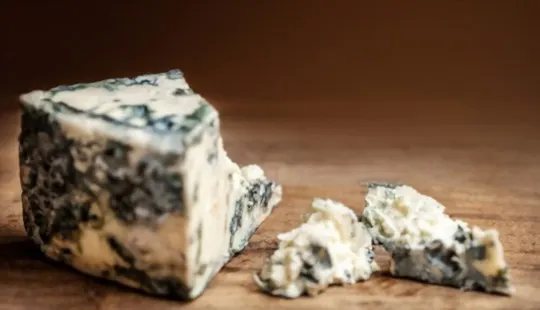Are you curious about Gorgonzola’s inimitable, complex flavor profile and want to know what it exactly tastes like?
Gorgonzola, an Italian blue cheese made with cow’s milk and traditionally aged for three months in caves has become increasingly popular among food enthusiasts.
With its unmistakable aroma, bold sharpness and mouthful of flavors ranging from salty, fruity to nutty-sweet that linger on your taste buds long after taking a bite – the complexity of this fascinating cheese makes people perplexed!
Whether you’re trying it for the first time or just hoping to learn more about its unique characteristics.
We’ve got all covered here for you with this comprehensive guide that dives deep into all things Gorgonzola!
What is Gorgonzola Cheese?

Gorgonzola cheese is an Italian blue cheese traditionally made from unpasteurized cow milk, but today you can find versions made with pasteurized milk.
It is also known as a stracchino, or mountain cheese.
Characteristically, Gorgonzola has a distinct flavor and soft texture, often described as creamy and crumbly in both body and rind.
Its flavor could be nutty and sweet, with slightly salty aftertastes.
To create Gorgonzola’s flavors, the cheese is aged for two to four months in cool temperatures with high humidity levels — this creates the typical blue veins that give it its namesake.
The best way to enjoy this distinguished cheese is to combine it with fresh fruits and vegetables like honeydew melon or apples for a delightful snack that will tantalize your taste buds.
When purchasing Gorgonzola, look for one that’s creamier near its rind — this indicates maturity with strong flavor nuances.
With such unique flavors and simplicity of usage, Gorgonzola can add new layers of sophistication to any dish.
What Does Gorgonzola Taste Like?

Gorgonzola is a type of blue cheese that has a strong, pungent flavor with a slightly sweet and nutty undertone.
This cheese is made from cow’s milk and is produced in the northern regions of Italy.
Gorgonzola cheese is characterized by its blue veining, which gives it a distinct appearance and flavor.
The intensity of the flavor can vary depending on the age of the cheese, with younger cheeses having a milder taste and older cheeses having a stronger, more complex flavor.
Gorgonzola has a creamy texture that lends itself well to a variety of dishes, such as salads, pizzas, and pasta sauces.
It pairs well with other bold flavors, such as red wine, honey, and walnuts.
Due to its strong flavor, it is best enjoyed in moderation, whether on its own or as part of a dish.
Ingredients and Aging that Affect the Taste of Gorgonzola Cheese

Gorgonzola cheese has a distinct taste that varies depending on the ingredients and aging process used in its production.
Here are some factors that affect the taste of Gorgonzola cheese:
- Ingredients: The type of milk used to make Gorgonzola cheese can affect its taste. Cheese made from cow’s milk has a milder, creamier taste, while cheese made from sheep’s milk or a blend of cow’s and sheep’s milk has a stronger, more pungent taste.
- Age: The aging process can also affect the taste of Gorgonzola cheese. Younger cheese has a milder flavor, with a tangy and slightly sweet taste. Aged cheese has a stronger, earthier flavor, with a sharper and more pungent taste.
- Other factors: Other factors that can affect the taste of Gorgonzola cheese include the type of bacteria used in the production process, the temperature and humidity levels during aging, and the use of additives such as mold spores or salt.
Whether you prefer a mild or strong taste, Gorgonzola cheese adds a unique flavor to any dish.
1 – Milk Type
Gorgonzola cheese has a tangy and earthy flavor, with a creamy and crumbly texture, making it a popular option for cheese lovers.
The taste and texture of Gorgonzola cheese can depend on the type of milk used in its production.
Here are the different types of milk used in Gorgonzola cheese and their taste profiles:
- Cow’s Milk: Gorgonzola made from cow’s milk has a milder taste, with less tanginess and a creamier texture.
- Goat’s Milk: Gorgonzola made from goat’s milk has a stronger flavor, with a sharper tanginess and a harder texture.
- Sheep’s Milk: Gorgonzola made from sheep’s milk has a distinct, nutty flavor and a crumbly, dry texture.
Ultimately, the type of milk used in Gorgonzola cheese production affects the cheese’s taste, texture, and aroma.
If you want to experience the unique flavor profile of Gorgonzola cheese, try experiencing it with different types of milk.
2 – Molding Process
Molding process is key to the unique taste and texture of Gorgonzola cheese.
Gorgonzola tastes like a creamy and tangy blue cheese with a distinctive earthy aroma and sharpness.
Here is everything you need to know about its taste and characteristics.
Gorgonzola cheese is crumbly and moist with blue-green veins running through it.
The texture can vary from smooth and creamy to firm and slightly grainy.
Its unique flavor comes from the molding process, where Penicillium mold spores are added to the cheese curd.
When aged for longer periods, Gorgonzola develops a stronger flavor and aroma.
The sharpness of the cheese is balanced out by a sweetness and nuttiness that lingers on the palate.
Gorgonzola pairs well with savory ingredients like roasted vegetables, cured meats, and pasta dishes.
Here are some key qualities of Gorgonzola cheese:
- Creamy and tangy with blue-green veins.
- Earthy aroma and sharpness.
- Crumbly and moist, with varying textures.
- Made with Penicillium mold spores during the molding process.
- Develops stronger flavor and aroma with aging.
3 – Aging Time
Gorgonzola cheese is a type of blue cheese that is aged for varying lengths of time, resulting in different levels of flavor and texture.
Here’s how the aging process affects the taste of Gorgonzola cheese:
- Young Gorgonzola (aged for 50-80 days): This type of Gorgonzola is soft and mild, with a creamy texture and a slightly sweet and tangy flavor.
- Gorgonzola Piccante (aged for 6-12 months): This type of Gorgonzola has a firmer texture than young Gorgonzola, with sharp and piquant flavor notes that intensify with age.
- Gorgonzola Naturale (aged for over a year): This type of Gorgonzola is the most intense and complex in flavor, with a dense and crumbly texture and a strong, spicy taste that lingers on the tongue.
So, the aging process plays a crucial role in determining the taste and texture of Gorgonzola cheese.
Different aging times result in different flavor profiles and textures, with some varieties being milder and creamier while others are crumbly and tangy.
Gorgonzola cheese pairs well with crackers, fruits, and nuts and can be used in various dishes such as salads, pasta, and pizzas to add an umami and salty flavor.
Culinary Uses of Gorgonzola Cheese

Gorgonzola cheese is a type of blue cheese characterized by its pungent, sharp, and tangy flavor.
The cheese has a soft, crumbly texture dotted with blue-green veins that give it a distinct appearance.
Here are some popular culinary uses of Gorgonzola cheese:
- As a topping for salads, pizzas, and sandwiches.
- As a flavoring for sauces, dips, and dressings.
- Paired with fresh fruits like pears, apples, and grapes.
- As a filling for omelets, quiches, and stuffed pastas like ravioli.
- For making creamy soups and risottos.
Gorgonzola cheese is a versatile ingredient in the kitchen, thanks to its strong and unique flavor profile.
It adds a distinct umami taste to any dish and pairs well with both sweet and savory flavors.
Is Gorgonzola Cheese Healthy?
When it comes to health, Gorgonzola cheese is not the best option due to its high-fat content.
However, it does offer some nutritional benefits to those who consume it.
One ounce of Gorgonzola cheese provides:
- 6 grams of protein.
- 6% DV of calcium.
- 0.2 mg of vitamin B12.
- 0.1 mg of riboflavin.
Gorgonzola cheese is a type of blue cheese that has a distinct, strong flavor that is sharp, tangy, and slightly sweet.
It has crumbly, creamy, and soft texture, making it a popular addition to salads, pizzas, and pasta dishes.
While Gorgonzola cheese has a bold flavor, its taste can vary depending on the aging process and the type of milk used to make it.
Young Gorgonzola has a milder taste, while aged Gorgonzola has a sharper flavor.
Where to Buy Gorgonzola Cheese and How to Store It?

Gorgonzola has a distinct flavor profile that ranges from creamy and mild to pungent and sharp.
It’s important to know where to buy Gorgonzola cheese and how to store it to ensure the best taste and quality.
Here’s where you can find and how to store Gorgonzola cheese:
Where to Buy?
- Local Cheese Shop: a cheese shop in your area is the best place to find the highest quality Gorgonzola cheese.
- Grocery Store: Most grocery stores stock Gorgonzola cheese in their deli or cheese sections.
- Online: Several online retailers sell Gorgonzola cheese, which can be a great option for those who don’t live near a cheese shop or high-end grocery store.
How to Store?
- Take your Gorgonzola cheese out of its original packaging and wrap it in a fresh piece of wax or baking paper.
- Store the wrapped cheese in an airtight container or resealable plastic bag.
- Place the container in the warmest part of your refrigerator, usually in the cheese or butter compartment.
- Properly stored Gorgonzola cheese will last for around two weeks, and the taste will become more pungent as it ages.
Conclusion
In conclusion, Gorgonzola cheese is a flavorful and complex cheese with a creamy texture and a pungent taste.
It has a slightly sweet and sharp flavor with earthy undertones and a distinctive blue mold that runs throughout the cheese.
Gorgonzola pairs well with bold flavors like red wine, honey, and walnuts and is a popular choice for salads, pizzas, and pasta dishes.
If you haven’t tried Gorgonzola cheese yet, it’s definitely worth a taste test to experience its unique flavor and texture.
Remember to store gorgonzola cheese properly to ensure its longevity – wrap it tightly in plastic wrap and store it in the fridge for up to one month.

What Does Gorgonzola Taste Like? A Comprehensive Guide
Ingredients
- Gorgonzola
- Ingredients from your selected recipes
Instructions
- Select your favorite ingredient from the range available in this article.
- Collect all the necessary items to make the recipe.
- Use the instructions provided to prepare a delicious dish in 30 minutes or less.

Carrie is a food writer and editor with more than 15 years of experience. She has worked for some of the biggest names in the food industry, including Bon Appétit, Food & Wine, and Martha Stewart Living.
As the Editor in Chief of IntroChicago.com, Carrie oversees all of the content on the site. She also manages the team of contributing writers and editors, who help to create delicious recipes, helpful tips, and informative articles that you’ll find on the site.
A native of the Chicago area, Carrie is passionate about all things food. She loves trying new restaurants and experimenting with new recipes in her kitchen. She’s also a graduate of the Culinary Institute of America, so she knows a thing or two about food!
